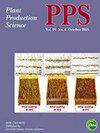甘蔗、Erianthus及其属间杂交种新栽时根系分布及硝态氮淋失评价
IF 1.3
3区 农林科学
Q2 AGRONOMY
引用次数: 1
摘要
摘要在日本西南诸岛等热带和亚热带岛屿地区,农田硝态氮淋溶对饮用水和环境保护产生不利影响。甘蔗在这些地区广泛种植,有必要提高甘蔗的氮素利用效率,以减少氮淋失。对该树种氮素利用的研究主要集中在产量潜力和肥料管理方面;然而,只有少数几次繁殖尝试。根系特征与氮素利用之间的关系尚不清楚,但由于其独特的根系特征,可以期望利用erenderthus提高氮素利用。本研究以甘蔗×鹰嘴花属间杂交种和亲本基因型的氮素淋溶和根系特性为研究材料,利用渗氮仪验证了改善甘蔗×鹰嘴花属间杂交种和亲本基因型氮素淋溶和根系特性的可能性。亲本Erianthus生长前期氮淋失显著低于亲本甘蔗,属间杂交种生长中期氮淋失显著低于亲本甘蔗。桔梗和属间杂交种的氮素利用效率显著高于甘蔗。与甘蔗相比,Erianthus和属间杂交种的茎根比和根深均较低,且深层土壤水分消耗显著,表明根系质量和根深可能是减少氮淋失的因素。这些结果表明,利用棱草改良甘蔗根系特性可以改善甘蔗氮素利用特性。图形抽象本文章由计算机程序翻译,如有差异,请以英文原文为准。
Evaluation of root distribution and nitrate leaching in sugarcane, Erianthus, and their intergeneric hybrid at new planting
ABSTRACT Nitrate-nitrogen leaching from farmland has adverse effects on drinking water and environmental conservation in tropical and subtropical island regions such as the Southwest Islands of Japan. Sugarcane is widely grown in these areas, and it is necessary to increase the nitrogen use efficiency of this crop to reduce nitrogen leaching. Studies on nitrogen utilization in this species have focused on yield potential and fertilizer management; however, there have been only a few breeding attempts. The relationship between root system characteristics and nitrogen utilization is also unclear, while improvement of nitrogen utilization using Erianthus can be expected because of its unique root system characteristics. In the present study, nitrogen leaching and root system characteristics of sugarcane × Erianthus intergeneric hybrid and parental genotypes were investigated using a lysimeter to verify the possibility of improving nitrogen utilization characteristics. Nitrogen leaching was significantly lower under the parental Erianthus from the early growth stage, while it was significantly lower in the intergeneric hybrid in the mid-growth stage than that in the parental sugarcane. The nitrogen use efficiencies of Erianthus and the intergeneric hybrid were significantly greater than that of sugarcane. Erianthus and the intergeneric hybrid exhibited lower shoot/root ratio and deeper rooting than sugarcane and consumed significant amounts of soil moisture in the deeper layers, suggesting that root mass and deeper rooting may be factors in reducing nitrogen leaching. These results indicate the possibility of improving the nitrogen utilization characteristics of sugarcane by improving its root system characteristics using Erianthus. GRAPHICAL ABSTRACT
求助全文
通过发布文献求助,成功后即可免费获取论文全文。
去求助
来源期刊

Plant Production Science
农林科学-农艺学
CiteScore
5.10
自引率
4.00%
发文量
27
审稿时长
>36 weeks
期刊介绍:
Plant Production Science publishes original research reports on field crops and resource plants, their production and related subjects, covering a wide range of sciences; physiology, biotechnology, morphology, ecology, cropping system, production technology and post harvest management. Studies on plant production with special attention to resource management and the environment are also welcome. Field surveys on cropping or farming system are also accepted. Articles with a background in other research areas such as soil science, meteorology, biometry, product process and plant protection will be accepted as long as they are significantly related to plant production.
 求助内容:
求助内容: 应助结果提醒方式:
应助结果提醒方式:


